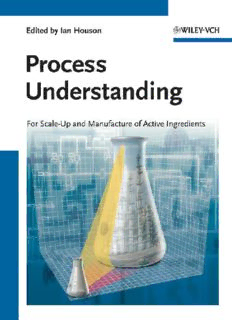
Process plant design : project management from inquiry to acceptance PDF
Preview Process plant design : project management from inquiry to acceptance
Editedby IanHouson ProcessUnderstanding Related Titles Helmus,F.P. Vogel,G.H. ProcessPlantDesign ProcessDevelopment ProjectManagementfromInquiryto FromtheInitialIdeatotheChemical Acceptance ProductionPlant 2008 2005 ISBN:978-3-527-31313-6 ISBN:978-3-527-31089-0 Bro¨ckel,U.,Meier,W.,Wagner,G.(eds.) Wiley-VCH(ed.) ProductDesignand Ullmann’sProcesses and Engineering Process Engineering BestPractices 2004 2007 ISBN:978-3-527-31096-8 ISBN:978-3-527-31529-1 Koolen,J.L.A. Rao,S. DesignofSimpleandRobust TheChemistryofProcess ProcessPlants Developmentin FineChemical 2001 andPharmaceuticalIndustry ISBN:978-3-527-29784-9 2007 ISBN:978-0-470-31995-6 Zlokarnik,M. Scale-upin Chemical Engineering 2006 ISBN:978-3-527-31421-8 Edited by Ian Houson Process Understanding For Scale-Up and Manufacture of Active Ingredients TheEditor AllbookspublishedbyWiley-VCHare carefullyproduced.Nevertheless,authors, Dr.IanHouson editors,andpublisherdonotwarrantthe GiltechLimited informationcontainedinthesebooks, 12NorthHarbourEstate includingthisbook,tobefreeoferrors. AyrKA88BN Readersareadvisedtokeepinmindthat UnitedKingdom statements,data,illustrations,procedural detailsorotheritemsmayinadvertentlybe inaccurate. LibraryofCongressCardNo.:appliedfor BritishLibraryCataloguing-in-Publication Data Acataloguerecordforthisbookisavailable fromtheBritishLibrary. Bibliographicinformationpublishedbythe DeutscheNationalbibliothek TheDeutscheNationalbibliothek liststhispublicationintheDeutsche Nationalbibliografie;detailedbibliographic dataareavailableontheInternetat <http://dnb.d-nb.de>. 2011WILEY-VCHVerlag&Co.KGaA, Boschstr.12,69469Weinheim,Germany Allrightsreserved(includingthoseof translationintootherlanguages).Nopart ofthisbookmaybereproducedinany form–byphotoprinting,microfilm,orany othermeans–nortransmittedortranslated intoamachinelanguagewithoutwritten permissionfromthepublishers.Registered names,trademarks,etc.usedinthisbook, evenwhennotspecificallymarkedassuch, arenottobeconsideredunprotectedbylaw. Composition LaserwordsPrivateLtd., Chennai,India PrintingandBinding betz-druckGmbH, Darmstadt CoverDesign Schulz,Grafik-Design, Fußgo¨nheim PrintedinFederalRepublicofGermany Printedonacid-freepaper ISBN:978-3-527-32584-9 V Contents Preface XV ListofContributors XVII 1 QualitybyDesign 1 VinceMcCurdy 1.1 History 1 1.2 DefiningProductDesignRequirementsandCriticalQuality Attributes 3 1.3 TheRoleofQualityRiskManagementinQbD 6 1.4 DesignSpaceandControlStrategy 12 1.5 QualitySystems 14 References 15 2 RouteandProcessSelection 17 DavidJ.Ager 2.1 Introduction 17 2.2 RouteEvaluation 20 2.3 FactorstoConsider 24 2.3.1 Timing 24 2.3.2 Costs 25 2.3.2.1 RemovalofaChromatographyStep 26 2.3.3 Safety,Health,andEnvironment(SHE) 26 2.3.3.1 SaferProcesses 28 2.3.3.2 GreenChemistry 33 2.3.4 Legal 37 2.3.5 OtherConsiderations 38 2.3.5.1 Throughput 40 2.3.5.2 Solvents 42 2.3.5.3 RawMaterials 43 2.3.5.4 Intermediates 43 2.4 RouteSelection 43 2.4.1 Sildenafil 48 VI Contents 2.5 ProcessSelection 49 2.5.1 Pregabalin 51 2.5.2 NK1ReceptorAntagonist 53 2.5.3 Data 55 2.6 Summary 56 References 57 3 CriticalStagesofSafetyAssessmentinProcessDesign andScale-Up 59 StephenRowe 3.1 ReactionSafetyConcepts 59 3.1.1 WhatIstheHazard? 60 3.1.2 TheCriticalEffectsofScale-UponThermalBehavior 60 3.1.3 SafetyFeaturesofaReaction 62 3.1.4 StagesofSafetyAssessment 64 3.2 Pre-LaboratorySafetyStudies 65 3.2.1 PredictingReactionSafetyCharacteristics 65 3.2.2 SelectingInherentlySaferProcessingConditions 68 3.3 TheSynergiesofSafetyandOptimization – Together 69 3.3.1 TestingofPotentiallyExplosiveCompounds 69 3.3.2 ThermalStabilityAssessment 70 3.3.3 ReactionThermodynamic,Kinetic,andGas-Generation Quantification 71 3.3.4 DevelopingFault-TolerantProcesses – byDesign 74 3.4 EstablishingaReliableBasisofSafetyforScale-Up 75 3.4.1 HazardousScenarioIdentification 76 3.4.2 DeterminingtheConsequencesofHazardousScenarios 77 3.4.3 ExperimentalSimulation – AdiabaticCalorimetry 77 3.4.4 SpecifyandImplementSafetyMeasures 79 3.4.5 Large-ScaleProduction 80 3.5 FlammabilityHazards 80 3.5.1 AssessingPilot-ScaleFlammabilityHazards 82 3.6 Summary 84 References 85 4 UnderstandingtheReaction 87 JohnAtherton,IanHouson,andMarkTalford 4.1 Introduction 87 4.2 ProcessComplexity 88 4.2.1 NumberofPhases 88 4.2.2 PhysicalandDynamicComplexity 89 4.2.2.1 LengthScales 89 4.2.2.2 Time 90 4.2.2.3 Solubility 90 4.2.2.4 Density 90 Contents VII 4.2.2.5 Rheology 90 4.2.2.6 HeatTransfer 90 4.2.2.7 MassTransfer/InterfacialArea 90 4.2.2.8 MixingTime 91 4.2.3 ChemicalComplexity 91 4.3 TopicsforDataAcquisition 91 4.4 ReactionProfiles 92 4.5 ReactionPictures 93 4.6 IonicEquilibriaandReactionSelectivity 95 4.6.1 Nitration 95 4.6.2 Acylation 96 4.6.3 AssociationEquilibria – LithiumDiethylamide(LDA) 99 4.7 Kinetics 99 4.7.1 OrderofReaction 99 4.8 CatalyzedProcesses 102 4.9 TheRate-DeterminingStep 102 4.10 MixinginChemicalReactors 105 4.11 MixingTheory 106 4.11.1 MixingRegimes 108 4.11.2 Micromixing 109 4.11.3 Macromixing 110 4.11.4 Mesomixing 110 4.11.5 DeterminingMixingSensitivityintheLaboratory 111 4.11.6 CommentsonScalabilityofMixing 111 4.12 MultiphaseProcesses 112 4.13 MassTransferTheory 113 4.13.1 EffectofMassTransferonChemicalReactionRates 114 4.13.1.1 ChemicalRate-LimitedReaction 114 4.13.1.2 MassTransferRate-LimitedReaction 114 4.13.1.3 Solubility-LimitedReaction 114 4.13.2 PhaseEquilibria 115 4.13.2.1 Partitioning 115 4.13.2.2 ‘‘SaltingOut’’ 115 4.13.2.3 CommonIonEffect 115 4.14 MassTransferandMixingRequirementsinMultiphase Systems 116 4.14.1 Liquid–LiquidSystems 116 4.14.2 Liquid–SolidSystems 118 4.14.3 Gas–LiquidSystems 118 4.14.4 Solid–Liquid–GasSystems 119 4.15 ConceptsofStructureandScaleforEquipmentSelection 120 4.15.1 WhatDoWeMeanby‘‘Structure’’? 120 4.15.2 Whatis‘‘Predictability’’? 121 4.15.3 Whatis‘‘Intensity’’? 121 4.15.4 ScalesofStructure 122 VIII Contents 4.15.5 HowSusceptibletoVariabilityistheProcess;WhenWouldDifferent EquipmentHelp? 123 4.16 Conclusion 124 References 125 5 UseofModelstoEnhanceProcessUnderstanding 127 WilfriedHoffmann 5.1 Introduction 127 5.2 TheProcessCharacterizationElementsofaChemicalReaction 128 5.3 TheImpactofModeling 130 5.4 UnderstandingtheChemistry 131 5.4.1 ASimpleStart 131 5.4.2 GettingRealRateParameters 132 5.4.3 IntroductionofTemperatureDependence 135 5.4.4 IncludingReactionHeats 137 5.4.5 PuttingElementsTogether:Large-ScaleSimulations 138 5.4.6 ThermalProcessSafetySimulations 141 5.5 PhysicalRates(theElementsofMassTransfer) 144 5.5.1 Gas/LiquidMassTransfer 145 5.5.2 Solid/LiquidMassTransfer 149 5.6 SummaryandOutlook 152 References 153 6 Scale-UpofChemicalReactions 155 E.HughStittandMarkJ.H.Simmons 6.1 Introduction 155 6.2 CaseStudy – BatchHydrogenation 156 6.3 Scale-UpofStirredTankReactors(STRs) 159 6.3.1 FundamentalsofFlowRegimes,Turbulence,andTurbulent Mixing 160 6.3.1.1 MixingMechanismsinLaminarFlows 161 6.3.1.2 MixingMechanismsinTurbulentFlows 162 6.3.1.3 EstimatingEnergyDissipationandMixingLengthScalesfrom TurbulentFlowFields 164 6.3.2 StirredVesselDesignandScale-Up 166 6.3.2.1 ImpellerFlowPatterns 167 6.3.2.2 PowerInputandSpecificEnergyDissipationRate 167 6.3.2.3 MixingTimes 170 6.4 StirredTankScale-Up 171 6.4.1 ChoiceofCriterionforScale-UpinTurbulentFlow 171 6.4.1.1 ConstantMixingTime(ConstantN) 171 6.4.1.2 ‘‘Constant’’TurbulentMixingBehavior(Constant ε ) 172 T 6.4.2 HeatTransfer 172 6.4.3 MultiphaseSystems:Solid–LiquidSystems 174 6.4.3.1 ParticleSuspensionandFlowPatterns 175 Contents IX 6.4.3.2 Solid–LiquidMassTransfer 177 6.4.4 MultiphaseSystems:Gas–LiquidSystems 177 6.4.4.1 PowerConsumption 178 6.4.4.2 GasHold-UpandFlowPatterns 178 6.4.4.3 MassTransfer 179 6.4.5 Summary 180 6.5 ChemistryEffectsinScale-Up 181 6.5.1 ‘‘Fed-Batch’’Liquid-PhaseReactions 181 6.5.2 Liquid–SolidReactions 182 6.5.3 Gas–Liquid(–Solid)Reactions 183 6.5.3.1 GaseousReactant 183 6.5.3.2 GaseousProduct 183 6.5.3.3 Catalysis 184 6.5.4 Impurities 184 6.6 AchievingProcessUnderstandingforReactorScale-Up 184 6.6.1 ChemistryScale-UpSensitivity 185 6.6.2 OntheAcquisitionofRelevantChemicalInformation 186 6.6.3 OntheAcquisitionofRelevantReactorDesignInformation 187 6.7 ReactorSelection 188 6.7.1 SoWhichReactorCanIUse? 188 6.7.2 GenericDuty 189 6.7.3 CharacterizingMixingRate 189 6.7.4 CharacterizingSolidsSuspension 190 6.7.5 CharacterizingHeatTransfer 190 6.7.6 CharacterizingMassTransfer 191 6.8 ExploitingProcessUnderstandinginScale-Up 191 6.8.1 MixingRate-LimitedReactions 192 6.8.2 Solid–LiquidMixing-LimitedReactions 193 6.8.3 Heat-Transfer-LimitedReactions 193 6.8.4 Mass-Transfer-LimitedReactions 194 6.9 Conclusions 194 References 195 7 ProcessUnderstanding – Crystallization 199 LeroyCronin,PhilipJ.Kitson,andChickC.Wilson 7.1 Introduction 199 7.1.1 CrystalDefinitionandStructure – CrystalDefectsandBasics ofCrystalGrowth 200 7.1.2 ThermodynamicsofCrystallization 202 7.1.3 KineticsofCrystalGrowth,Nucleation 204 7.1.3.1 MetastableStates 206 7.1.4 NucleationandCrystalGrowth 206 7.1.4.1 SupersaturationandMetastableZoneWidth 206 7.2 CrystallizationProcesses 208 7.2.1 CrystallizationfromtheMelt 208
